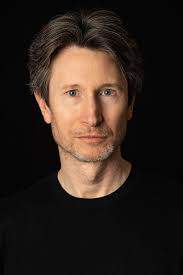Radioactive 2020

As Marie Curie's trailblazing journey unfolds, she forges an unbreakable bond with Pierre, kindling a passion that extends from their laboratory work to a deeply personal love story. Together, they revolutionize science, defying conventions and reaping the Nobel Prize in 1903 – a testament to her indomitable spirit as the first female winner.
Does Radioactive have end credit scenes?
No!
Radioactive does not have end credit scenes.
Actors
Meet the cast of Radioactive and learn about the talented actors who brought the characters to life. Explore their roles and career highlights.

Corey Johnson

Aneurin Barnard
Paul Langevin

Sam Riley
Pierre Curie

Anya Taylor-Joy

Simon Russell Beale
Professor Lippmann

Rosamund Pike
Marie Curie

Michael Gould

Tim Woodward

Jonathan Aris

Péter Fancsikai

Cara Bossom

Drew Jacoby
Loie Fuller

Faye Bradbrook
Bronia's Maid

Harriet Turnbull
Young Marie

Indica Watson
Irène Aged 6

Mirjam Novak
Nurse

Ralph Berkin
Doctor

Sian Brooke
Bronia Sklodowska

Yvette Feuer
Carla
Links
Explore where to watch Radioactive online. Find reviews, ratings, and detailed movie information on other platforms like Metacritic, Rotten Tomatoes, TMDb or JustWatch
Ratings
Discover how Radioactive is rated on popular platforms like IMDb, Metacritic, and TMDb. Explore audience and critic scores to see how this movie ranks among the best.

56
Metascore
5.1
User Score


%
TOMATOMETER

0%
User Score

66
%
User Score

2.8
From 31 fan ratings

3.75/5
From 4 fan ratings
Movie Quiz
Challenge your knowledge of Radioactive with an engaging quiz. Test your memory of the movie’s characters, plot twists, and unforgettable moments.
Radioactive - Quiz Time: Test your knowledge on the life and discoveries of Marie Curie as depicted in the movie 'Radioactive'.
In which year does the movie 'Radioactive' primarily unfold?
Plot Summary
Get the full story of Radioactive with a detailed plot summary. Dive into its themes, characters, and the twists that make it a must-watch.
As the year 1934 dawned in Paris, a frail Marie Curie (Rosamund Pike) found herself in a hospital, with fragments of her past swirling around her like smoke. Her mind drifted back to the streets of 1893, where she first encountered Pierre Curie (Sam Riley), a fortuitous meeting that would irrevocably change her life. During this earlier period, Marie Sklodowska, struggling against the harsh realities of being a woman in a male-dominated scientific realm, confronted Professor Lippmann (Simon Russell Beale), passionately defending her research against his blatant disregard. Despite his condescending attitude, Marie stood firm, sharing her frustrations with her sister Bronia (Sian Brooke). However, the persistent rejections threatened to extinguish her determination.
Fate shifted in a promising direction when she reconnected with Pierre, an academic who not only recognized her name but also revered her work. He extended his hand in collaboration, offering her shared lab space, which Marie initially rejected, only to reconsider after a fire sparked at home due to a careless mistake. Their burgeoning collaboration yielded surprising insights, revealing that uranium, once believed to be reliant on external factors for radiation, was intriguing in its own right, hinting at the existence of an undiscovered element.
Supported by Pierre, who realized the inadequacies of their current equipment, they set out to create a quadrant electrometer to measure electrical potential. Over dinner with friends Paul Langevin and his wife, Pierre recounted their quest to isolate elements from ore, while Marie emphasized that the reactions of uranium stemmed solely from the element itself.
As their professional bond deepened, Pierre’s affection for Marie blossomed; though hesitant at first, she eventually accepted his proposal, leading to a swift wedding ceremony. Shortly after their honeymoon, Pierre disclosed their future collaboration with Paul in a cutting-edge research facility. Over the years, they welcomed their daughter Irène and made monumental discoveries, unearthing two new elements: polonium and radium. Their groundbreaking findings reverberated through the scientific community, with Marie coining the term “radioactivity,” a word that would become widely recognized and revered, paving the way for their Nobel Prize nomination.
As Pierre ascended to a professorship, Marie prepared for the birth of their second child, while the world began to realize the transformative potential of radioactivity. Amidst the enthusiasm, Pierre was elated to learn of radium’s application in cancer treatment, believing their work could fundamentally alter human history.
Fast-forward to 1957 in Cleveland, a doctor employs radioactive technology to treat a young cancer patient, a powerful illustration of the far-reaching influence of their discovery. Complications arose when Pierre became captivated by a mystic claiming the ability to channel spirits through radioactivity, a development that troubled Marie. Upon the birth of their second daughter, Eve, Pierre shared with her the exciting news: their research had been acknowledged by the Nobel Committee—yet only under his name.
Determined to correct this injustice, Pierre humbly accepted the award alongside Marie in Stockholm in 1903, cautioning against the potential dangers of their discovery falling into unworthy hands. As he delivered his acceptance speech, he pondered if humanity was ready for the ramifications that would follow, foreshadowing the grave moment when the atomic bomb would be dropped on Hiroshima in 1945.
As Pierre returned home, grappling with the fallout of his success, he was faced with Marie’s fury for his perceived overshadowing of her contributions, a confrontation culminating in her striking him. The film then leads to the tragic moment when Pierre suffers a fateful mishap on his journey home, crushed by a horse and cart in a heart-wrenching twist of fate, forever altering Marie’s world and plunging her into a cycle of despair haunted by nightmares.
In the aftermath, Professor Lippmann offered Marie a path back to prominence by inviting her to succeed Pierre at the prestigious Sorbonne. Initially hesitant, Marie’s resilience ultimately prevailed, and she took on the role, driven by her passion for science. While navigating this new phase, Paul, who attempted to offer comfort, failed to alleviate her pain as she contended with an onslaught of public scrutiny following the rumors swirling around her.
The gossip turned cruel when the wife of Paul labeled her a “dirty pole,” asserting she had unleashed a toxic legacy upon the world. During this turbulence, Marie’s daughters witnessed their mother’s struggles and were met with resistance as Marie endeavored to shield them from the harsh reality surrounding her.
In a poignant search for peace, Marie consulted with a mystic to commune with the spirit of Pierre, grappling with the incessant loss. A mystic’s revelation to her about her own fading vitality served to heighten her longing for connection, as her assistant pleaded for the spirit world to grant her reprieve from the burdens of grief.
Fragments of her past intertwined with 1986’s catastrophic Chernobyl meltdown, highlighting Bronia’s decision to retreat amidst public vitriol directed at Marie. However, her tenacity to prioritize her work over personal safety kept her grounded.
Years later, Marie’s unparalleled dedication culminated in a second Nobel Prize, although she paid little heed to warnings against stirring the pot. Instead, upon attending the ceremony, she discovered encouragement from a burgeoning women’s movement, leading to a spontaneous ovation from the assembled crowd.
In the present, adult Irène (Anya Taylor-Joy) encouraged Marie to contribute to the war effort, yet Marie remained steadfast against entering combat, instead, agreeing to assist by providing equipment. As Irène introduced Frederic, a passionate young researcher, into their lives, Marie felt torn between cautioning her against the dangers of radiation while appreciating Frederic’s fervor.
Together, they approached Alexandre Millerand, the war minister, lobbying for mobile x-ray units to assist frontline medical treatment. Initially met with reluctance from Millerand and Professor Lippmann due to budget constraints, Marie’s unwavering resolve led her to propose melting down her Nobel Prize medals, emphasizing her sacrifice for progress in medical treatment. Ultimately, her efforts bore fruit, securing the deployment of crucial units to battlefield.
As Marie and Irène ventured into war-torn territory, the dire reality of their mission contrasted starkly with the optimism of their laboratory days. While attending to the wounded, Marie fell into a reverie, blending past and present, as an older Marie lay in a hospital bed surrounded by echoes of moments both significant and tender with Pierre. His encouragement underscored her tremendous contributions, culminating in a heartfelt kiss that solidified their legacy.
The narrative chimes forward, revealing that upon Marie’s passing, she was interred beside Pierre, a lasting homage to their shared journey. In a closing chapter, Irene and Frederic’s collaboration resulted in a Nobel Prize for their groundbreaking discovery of artificial radioactivity, a profound achievement mirroring Marie’s relentless spirit. The legacy endures as the Curie discoveries continue to aid in the fight against cancer, affirming that Marie Curie’s unwavering dedication profoundly shaped the future of science and human compassion.
Videos
See the latest videos related to Radioactive. Explore trailers, interviews, and behind-the-scenes content that give you a deeper look into the film.
Movie Cars
Explore the iconic cars featured in Radioactive. Discover the vehicles that played a role in the movie, their details, and their significance.
Keywords
Discover the keywords that describe the themes and topics of the movie. Explore the keywords that define the essence of the film.
Featured on this page

What's After the Movie?
Not sure whether to stay after the credits? Find out!
Check out our other apps:
Actors
Companies
Latest Movies
© 2025 What's After the Movie. All rights reserved.
























